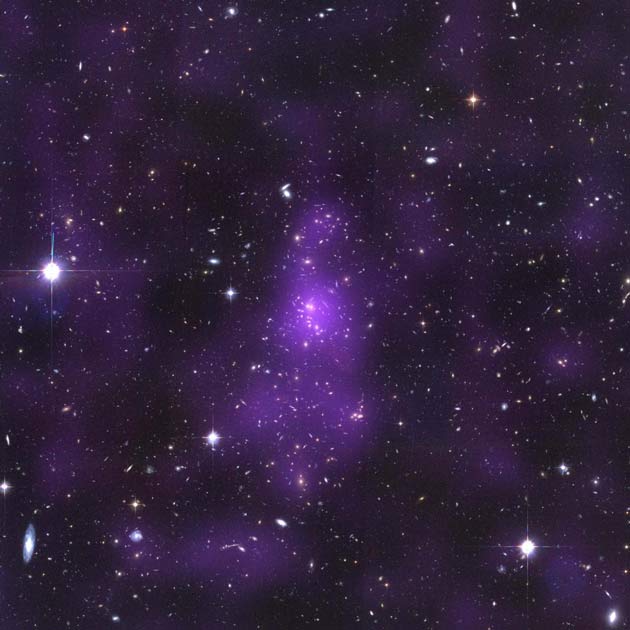Hubble Sheds Light on Dark Matter

Astronomers don't know what it is, but every now and then they find more evidence of dark matter and pin down where the mysterious stuff resides.
A new project that recycled Hubble Space Telescope images has mapped the invisible dark matter with unprecedented detail. Researchers focused on two galaxy clusters that are so far away, and their light has taken so long to get here, that they are seen as they existed when the universe was about half its present age.
The observations provide additional evidence supporting a leading theory that galaxies form in cosmic webs, with regular material and dark matter condensing into nodes something like water drops gather at intersections of spider silk.
You can also think of it as froth gathering on the tops of ocean waves, said study team member Myungkook James Jee at Johns Hopkins University.
Strange stuff
Dark matter is thought to exist because without it, galaxies would fly apart for lack of gravitational glue. However mapping something that can't be seen is problematic.
"It is very challenging to verify the simulation results observationally, because dark matter does not emit light," Jee said.
Get the Space.com Newsletter
Breaking space news, the latest updates on rocket launches, skywatching events and more!
The trick is to look for subtle distortions in the images caused by gravitational lensing, in which the shapes of very distant galaxies are warped by dense concentrations of matter between us and the galaxies. The matter, which is not visible, bends the light with its gravity, and that reveals its presence.
"The images we took show clearly that the cluster galaxies are located at the densest regions of the dark matter haloes, which are rendered in purple in our images," Jee said.
The results are detailed in the December issue of Astrophysical Journal.
Dark matter makes up about 90 percent of the universe's total. Theory holds that it should gather with regular matter, because of their mutual effects of gravity. The new observations support that idea, Jee said.
The work also supports the notion that dark matter is not made of particles that can collide. It's not known if dark matter involves particles at all, but if so, they must be collisionless.
"Collisionless particles do not bombard one another, the way two hydrogen atoms do," Jee said. "If dark matter particles were collisional, we would observe a much smoother distribution of dark matter, without any small-scale clumpy structures."
The two clusters each contain more than 400 galaxies.
"These images were actually intended mainly to study the galaxies in the clusters, and not the lensing of the background galaxies," said co-researcher Richard White of the Space Telescope Science Institute, which operates Hubble for NASA. "But the sharpness and sensitivity of the images made them ideal for this project. That's the real beauty of Hubble images: They will be used for years for new scientific investigations."
- Dark Matter: Invisible, Mysterious and Perhaps Nonexistent
- Dark Matter Exposed: Animation Offers Clues to Cosmic Mystery
- Missing Matter Found, Partially Squaring Cosmic Accounting Sheets
Join our Space Forums to keep talking space on the latest missions, night sky and more! And if you have a news tip, correction or comment, let us know at: community@space.com.

Rob has been producing internet content since the mid-1990s. He was a writer, editor and Director of Site Operations at Space.com starting in 1999. He served as Managing Editor of LiveScience since its launch in 2004. He then oversaw news operations for the Space.com's then-parent company TechMediaNetwork's growing suite of technology, science and business news sites. Prior to joining the company, Rob was an editor at The Star-Ledger in New Jersey. He has a journalism degree from Humboldt State University in California, is an author and also writes for Medium.